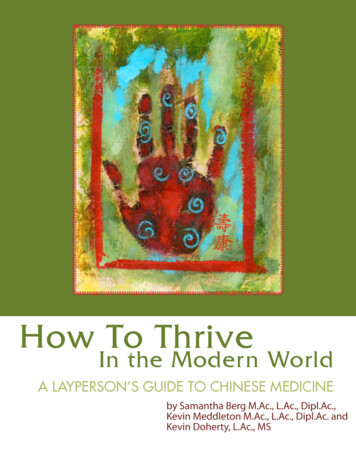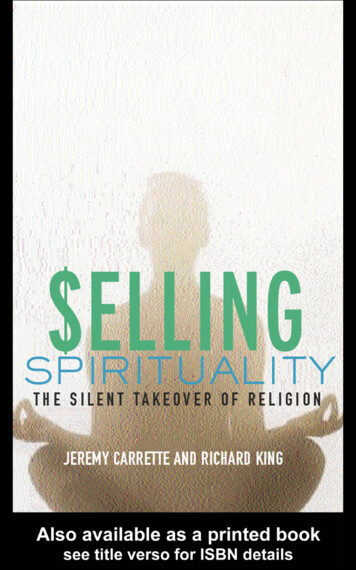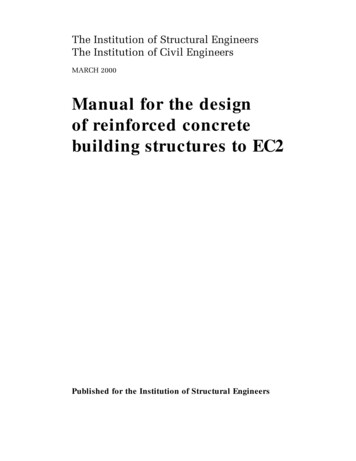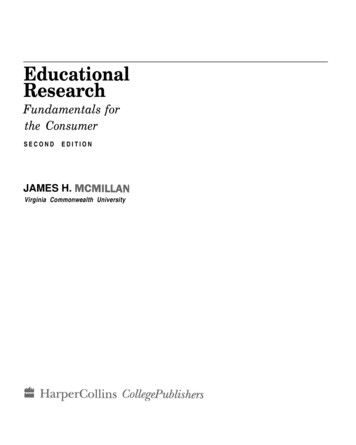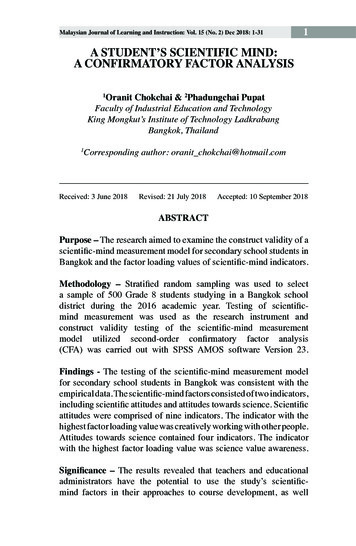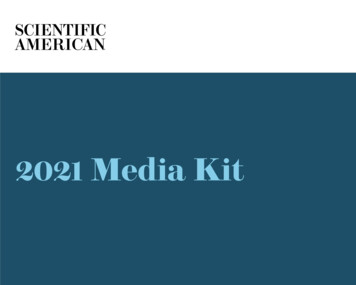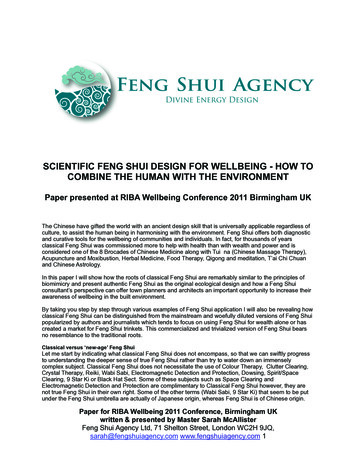
Transcription
SCIENTIFIC FENG SHUI DESIGN FOR WELLBEING - HOW TOCOMBINE THE HUMAN WITH THE ENVIRONMENTPaper presented at RIBA Wellbeing Conference 2011 Birmingham UKThe Chinese have gifted the world with an ancient design skill that is universally applicable regardless ofculture, to assist the human being in harmonising with the environment. Feng Shui offers both diagnosticand curative tools for the wellbeing of communities and individuals. In fact, for thousands of yearsclassical Feng Shui was commissioned more to help with health than with wealth and power and isconsidered one of the 8 Brocades of Chinese Medicine along with Tui na (Chinese Massage Therapy),Acupuncture and Moxibustion, Herbal Medicine, Food Therapy, Qigong and meditation, T’ai Chi Chuanand Chinese Astrology.In this paper I will show how the roots of classical Feng Shui are remarkably similar to the principles ofbiomimicry and present authentic Feng Shui as the original ecological design and how a Feng Shuiconsultant’s perspective can offer town planners and architects an important opportunity to increase theirawareness of wellbeing in the built environment.By taking you step by step through various examples of Feng Shui application I will also be revealing howclassical Feng Shui can be distinguished from the mainstream and woefully diluted versions of Feng Shuipopularized by authors and journalists which tends to focus on using Feng Shui for wealth alone or hascreated a market for Feng Shui trinkets. This commercialized and trivialized version of Feng Shui bearsno resemblance to the traditional roots.Classical versus ‘new-age’ Feng ShuiLet me start by indicating what classical Feng Shui does not encompass, so that we can swiftly progressto understanding the deeper sense of true Feng Shui rather than try to water down an immenselycomplex subject. Classical Feng Shui does not necessitate the use of Colour Therapy, Clutter Clearing,Crystal Therapy, Reiki, Wabi Sabi, Electromagnetic Detection and Protection, Dowsing, Spirit/SpaceClearing, 9 Star Ki or Black Hat Sect. Some of these subjects such as Space Clearing andElectromagnetic Detection and Protection are complimentary to Classical Feng Shui however, they arenot true Feng Shui in their own right. Some of the other terms (Wabi Sabi, 9 Star Ki) that seem to be putunder the Feng Shui umbrella are actually of Japanese origin, whereas Feng Shui is of Chinese origin.Paper for RIBA Wellbeing 2011 Conference, Birmingham UKwritten & presented by Master Sarah McAllisterFeng Shui Agency Ltd, 71 Shelton Street, London WC2H 9JQ,sarah@fengshuiagency.com www.fengshuiagency.com !1
The truth of the matter is that these other subjects are simpler and easier to understand than the classicalFeng Shui systems which require an understanding of Chinese Characters, a flexible intellect and manyyears of study with a good teacher. The focus on the simpler subjects is a way of providing short termgratification for people seeking to distract themselves with the latest fad or they can sometimes act as anintroduction to the subject, but in my experience largely act to repel the modern person interested inintelligent design and keep them at a distance from the profound beauty of the classical systems.The components of Classical Feng Shui – how to combine the human with the environmentFeng Shui is essentially showing us how to combine the human with the environment. In a classicaltraining much time is spent outdoors in nature, observing the landform, flora and fauna and how it allworks together symbiotically and changes over the seasons. There is a dual focus on form and directionalenergy measured by a Lopan Compass. Form, as the name suggests, concerns itself with the topographyof the natural surroundings and the shapes in the manmade urban environment. The compass focusconcerns itself with the quality of energy provided by different compass directions. The cycle of a dayitself shows us that the quality of sunrise and the sun from the North East/East is tangibly different fromthe quality of the sunset in the West. The sunrise has an energetic, rising and uplifting feeling to itwhereas the sunset has a dreamy, settling, relaxing quality. Classical Feng Shui considers not only withthe Four Cardinal Directions and the Four Sub-Cardinal Directions but these can be further subdividedinto 24 then 64 sections, each with unique characteristics.!Figure 1. The intricate classical Chinese Lopan Compass demonstrating the refinement of 64 kuas within the8 directionsFeng Shui is not just for the Chinese but is a universally relevant wisdomIt must be clearly understood that whilst Feng Shui has its roots in China it is not simply a culturalsuperstition or belief system. Chinese speaking people cannot understand Feng Shui terminology justbecause they speak Mandarin or Cantonese, because it is uses a language of its own, so it is alsoerroneous that Chinese practitioners are somehow better or more suited to Feng Shui. In fact, some ofthe Hong Kong style Feng Shui on offer today is largely made up of old wives tales and superstitions thatare actually just inaccurate renditions of ancient stories and because Feng Shui was outlawed underChairman Mao’s regime, many practitioners fled to Taiwan and Singapore, and much knowledge waseither lost, destroyed or mistranslated, so it is very important to learn from a teacher with an undilutedlineage, such as Grand Master Chan Kun Wah who is a Yuen Hom Master from a lineage going back tothe Imperial Courts of China.Life-force energy is a universal force governing all mankindFeng Shui is primarily concerned with how to observe, protect and strengthen ‘chi’ or life force energy.Many other wisdom traditions, not just the Chinese, have words describing the animating force of life – inJapan it is known as ‘ki’ , in Ayurvedic tradition it is referred to as ‘prana’, in Cherokee Shamanic traditionsPaper for RIBA Wellbeing 2011 Conference, Birmingham UKwritten & presented by Master Sarah McAllisterFeng Shui Agency Ltd, 71 Shelton Street, London WC2H 9JQ,sarah@fengshuiagency.com www.fengshuiagency.com !2
‘the spirit that moves through all things’ and even in the West we have terms such ‘orgone’ (WilhelmReich) and the Latin term Genus Loci, meaning ‘spirit of place’ also indicates that space has a spirit orenergetic quality and is not just a physical resource for the manipulation or dominion by humans. When acorpse is presented to us we can see the shell of the person or animal that was there and we have avisceral sense of the spirit or animating force no longer being contained in that physical shell. Society haslong since moved away from Newtonian physics of world as machine towards a greater awareness ofquantum fields and theories of interconnectivity.“If we looked at nature as a model for design we could find that in its intelligence everything is connected.This connectivity is expressed in the smallest electron arrangement to the largest macroscopic stellaralignment. Everything seems to produce an effect on something else, a connection a link between itssurroundings a relation to its Whole.” [1]Contrary to popular belief, the concept of Chi is not as mystical as it might at first sound. When we trulyunderstand the nature of energy we can actually become more and more grounded and pragmatic in ourapproach to design. Like natural structures and animal habitats work with what they find in thesurrounding environment and seek to build in an energetically sustainable and minimally laborious way,the Feng Shui consultant seeks wherever possible to harmonise and integrate with what is already in theenvironment both from a physical and energetic perspective. This does not mean that we designeverything with soft curves and focus only on some sort of vague ‘flow’, there is much more to Feng Shuithan ergonomics.Chi follows form - the acupuncture of spaceJust as the contours of the seabed influence the currents of the sea, the physical topography and physicaldesign of a space influences the flow of chi. Looking beyond the obvious organisational andpsychological benefits of a tidy and clutter free environment, we are creating spaces which are inalignment with natural law and natural energies that the Chinese have charted for thousands of years. Forinstance, without the need for microscopes or quantum physics the Chinese already perceived thesystem of energy meridians throughout the body connected to internal organs and developed the highlyeffective system of acupuncture. Feng Shui is essentially the ‘acupuncture of space’.Suspension of disbelief – using the Feng Shui ‘Pattern Book’We all know that the Moon governs the tides and the Sun fosters life and water falls in the form of rainfrom the skies to nourish the Earth, so is it really such a leap of faith to include the rest of the planetaryand stellar system and entertain the idea that Venus, Mars and Mercury might also influence life onEarth? It is particularly foolish to disregard the notion of Feng Shui when consultants over and over againare experiencing Feng Shui as a really effective tool, to both diagnose sickness in a building and offercurative or preventative measures. I invite you to put on a pair of Feng Shui glasses to view the worldthrough the lens of Feng Shui wisdom and accompany me on a journey of discovery.Just as architects and urban planners have worked with pattern books to maintain the look of a certainneighbourhood or development, Feng Shui can be considered as a type of pattern language and atemplate through which to create designs. This can be both restrictive and also freeing. Sometimes whenfaced with a blank canvas or a large flat piece of land with no particularly prominent features it can beequally hard to create a scheme than if the designer had restrictions placed upon them by localtopographical conditions. With Feng Shui you can quickly create a cohesive sense of the place and gaininspiration for a suitable design and utilise a variety of Feng Shui techniques, some more suited to largerspaces and some more suited to smaller spaces and some focusing purely on the qualities of auspicioustiming.Classical Feng Shui starts from the outside of a property or from the surroundings of a city to determinehow the property or how the city is ‘sitting’ within a certain area. Once the observations have been maderegarding the physical surroundings the aim of harnessing and circulating the natural life force energy canbe better achieved. One of the most important dynamics in Feng Shui is the relationship of Yin and Yang(Female principle and Male principle) which constitute the 8 Trigrams.Paper for RIBA Wellbeing 2011 Conference, Birmingham UKwritten & presented by Master Sarah McAllisterFeng Shui Agency Ltd, 71 Shelton Street, London WC2H 9JQ,sarah@fengshuiagency.com www.fengshuiagency.com !3
8 Trigrams of the I ChingOne of the most important Feng Shui patterns or templates is the two arrangements of the Trigrams. Atrigram is a three lined symbol consisting of Yin & Yang.!Figure 2. The metaphysical model of life force and the interplay of Yin/Yang creating the I Ching TrigramsFeng Shui terminology can seem abstruse or generic to the uninformed. However, the multifaceted natureof manifestation is such that there are no absolutes, only tendencies, so the Chinese language aptlydescribes principles that are ever changing yet similar. Mystery of the Void – this is the specialism ofChue Style Feng Shui that I practice and it alludes to the invisible becoming visible, the unmanifestbecoming manifest. Central to this style of Feng Shui are the 64 hexagrams of the I Ching that arecomprised of the 8 Trigrams. Ultimately if we deconstruct the trigrams we end up with simply yin (feminineor minus) and yang (masculine or plus). Out of a primordial nothingness the identity of yang (or light orpositive pull) requires by necessity the identity of its opposite yin (or dark or negative pull) otherwise itcannot be a distinctive impulse without the opposite dynamic. Yang can then be joined by another yangline or a yin line. Yin can be joined by another yin line or a yang line. We are reminded of binary code ofcomputer code 1010001 etc.64 strands of DNA and the 64 HexagramsAccording to Dr Martin Schoenberger there is a direct correlation between the characteristics of the 64strands of DNA and the characteristics of the 64 Hexagrams. The DNA helix is denoted as either plus orminus – hexagrams are comprised of either yin (-) or yang ( ). There are four letters , three of whichdetermine the DNA label - there are four states of yin/yang, three of which determine the trigram. Thedirection in which the DNA code words are read is strictly determined, as is the direction in which atrigram is read. There are 64 DNA triplets and 64 hexagrams. [2]Did the Chinese discover a binary code of creation and natural law? How would this be relevant towellbeing and the built environment? The position of the trigrams are related to certain directions andbody parts or organs and the quality of energy in these directions affects the health of the body part/organ. See the diagram below for the Exterior space or Early Heaven conditions.Paper for RIBA Wellbeing 2011 Conference, Birmingham UKwritten & presented by Master Sarah McAllisterFeng Shui Agency Ltd, 71 Shelton Street, London WC2H 9JQ,sarah@fengshuiagency.com www.fengshuiagency.com !4
!Figure 3. The Early Heaven Directional Arrangement of I Ching Trigrams and Associated Body Parts used toassess the Exterior environment of a property or area zoneBodily Health Linked to Environmental Exterior EnergyAccording to Chinese cosmology different directions have a resonance with different internal organs orbody parts as depicted in the Figure.1 above. So if we find a problematic influence such as anexcessively tall tree close to the house in the South it could cause problems associated with the head,such as headaches, migraine and even brain tumour because the tree is cramp
Life-force energy is a universal force governing all mankind Feng Shui is primarily concerned with how to observe, protect and strengthen ‘chi’ or life force energy. Many other wisdom traditions, not just the Chinese, have words describing the animating force of life – in Japan it is known as ‘ki’ , in Ayurvedic tradition it is referred to as ‘prana’, in Cherokee Shamanic .



